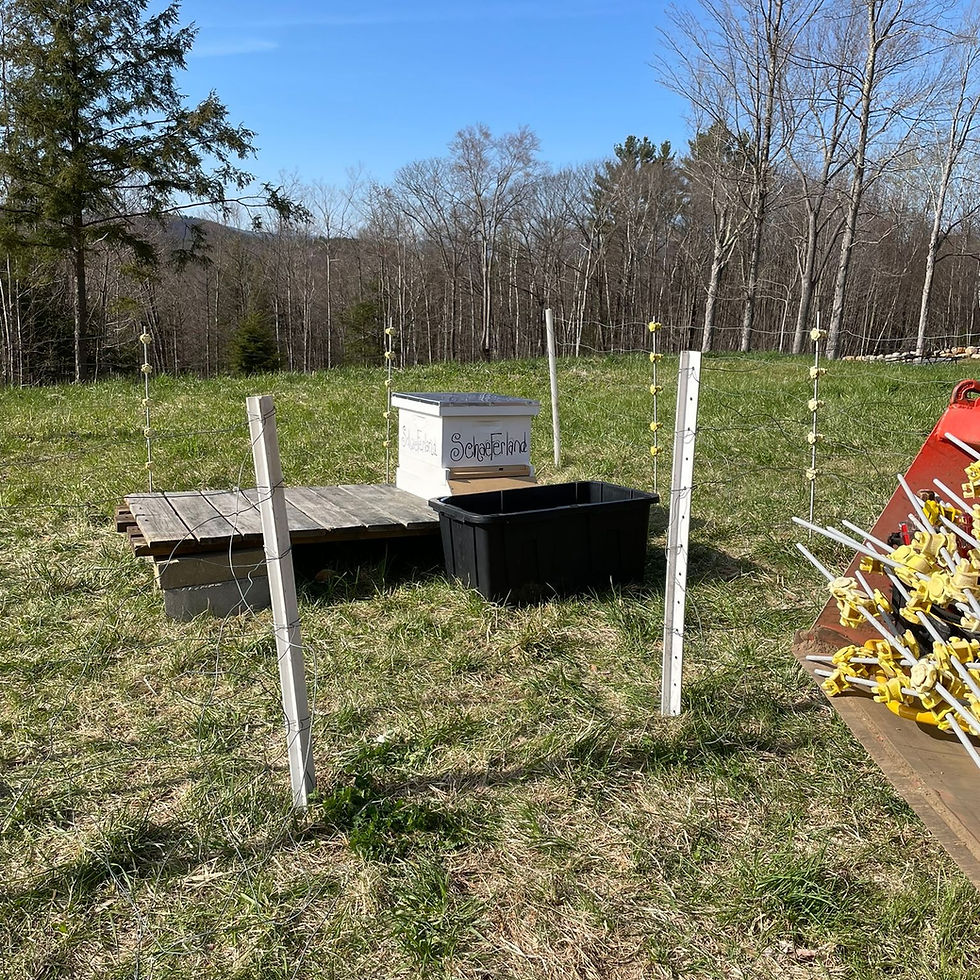Exploring Ecopsychology: BEE-ginner Beekeeping- Part 2 Preparation, Infrastructure and Set up
- Justine Ferland
- May 1, 2022
- 4 min read
Updated: 19 hours ago
At SEELEDU we are lucky to be surrounded by family on two continents that share our vision and love of nature! Our family in Germany supports 6 hives bringing in over 30,000 bees and our family in NH is about to launch our first 2 hives!

Follow along with us here as we dive into BEE-ginner beekeeping and we share step by step through the process!
BEE-ginner Beekeping: Part 2 Preparation, Infrastructure and Set up
But first, why are bees important to us at SEELEDU?
At SEELEDU we teach you to connect both through and with nature. We are passionate about creating strong local gardens, communities and improving our local biodiversity. Scientists are seeing an alarming decline in bee populations worldwide. Half of the 570 species of wild bees in Germany are at risk of extinction (.de, 2018)! In the USA, neonicotinoids are the most popular insecticides used and hundreds of studies have shown they play a major role in population-level declines of bees, birds, butterflies and freshwater invertebrates (Burd, 2021).
To live in accordance with our beliefs, it was natural to expand to beekeeping!
BEE-ginners Beekeeping: A step by step look at setting up your own hive
The bee’s delivery have been delayed due to bad weather, but we have some luck there as we have close to no flower activity in the moment. With the delayed delivery date, temperatures will improve bringing more early season pollinators. Check out why dandelion is one of our favorite pollinators here! Not sure what a pollinator is? We can help!
We really thought that we would just put up the hive and that would be it… but nothing is ever that simple. These first steps were all about setting up infrastructure which took longer and had more steps than we thought.

First we had to paint and retrieve the hive boxes. We painted them white because we had some leftover white exterior paint from other projects; however, we have seen other brightly colored hive boxes. Our family in Germany has yellow boxes for example. We learned that when there are multiple hives, to help the bees identify the hive to put a different mark like a circle, square or rectangle on the box. Bees cannot see the color red.

Our local Bee Experts, Pemi Baker Bee Keepers Association, informed us not to paint where the bees touch. So the ramp to enter the hive and the inside was left untouched.
Then we had to search the land to find a location and decide which direction to place the hives….. Our property has a 20% grade so we were looking for a relatively flat and easy to access area. We positioned the set up with Southerly exposure to help get the bees moving faster in the morning. Hives should be in an area that receive morning sun and also close to a water source. We placed ours on the border with the forest and our apple orchard and wildflower meadow for lots of pollinator opportunities for our bees and with a small river nearby running through the forest.
It's important to mention, black fly season has begun and in NH this can be extreme. We geared up with a netted hat to protect the black flies from swarming in the face. Black flies are a real nuisance this time of year but essential to local river and stream ecosystems (Malmqvist, 2004).

Next up was assembling the electric fence. We live in black bear country and they would love a tasty treat of honey! The fence also took longer than expected having to set 8 foot ground rods, setting posts, watching several hours of Youtube videos, & unspooling & running wire. The wire was 14 cage wire which is quite thick and was more difficult to manipulate than expected.
Estimated time investment in BEE-ginner beekeeping project to this point: Approx. 60 hours invested & no bees yet***

Next steps in BEE-ginner beekeeping project:
making a battery box to protect the battery from the weather (did you know NH is home to the world’s most extreme weather?)
setting up the battery to the electric fence
making a kill switch and level platforms for the hives to sit on so they are not too close to the ground for all critters to go into
wait with excitement for the bees to arrive!
***It is important to note that all time spent this year will be for no honey! The bees themselves need this year to establish their colonies.
SEELEDU explores the journey of being human and nurtures nature connections for health and well-being.
SEELEDU is passionate about teaching you to connect in and with nature. As active homesteaders and practicing ecopsychologists, one of our favorite tools to connect is through home, community or school gardens. Justine Ferland, the founder of SEELEDU, lives in accordance with ecopsychological beliefs. She encourages a local slow food movement, leading and assisting in community gardens and agricultural practices. Justine celebrates the local cultural and native histories seeking out knowledge from native practice experts, local forest managers, horticultural experts, conservationists, scientists, topic experts and more. Justine’s family in America and Germany also live in accordance with these beliefs as homesteaders and business leaders using design to help solve problems that can lower our environmental impact.

References:
(2018). Small creatures with a big impact. deutschland.de: https://www.deutschland.de/en/topic/environment/bees-at-risk-germanys-strategy-for-protecting-bees
Burd, L.A. (2021). EPA: Neonicotinoid Pesticides Harm Vast Majority of All Endangered Species. Center for Biologal diversity. https://biologicaldiversity.org/w/news/press-releases/epa-neonicotinoid-pesticides-harm-vast-majority-of-all-endangered-species-2021-08-26/#:~:text=Neonicotinoids%20are%20used%20on%20hundreds,millions%20of%20acres%20each%20year.
Malmqvist, B., Adler, P.H., & Kuusela, K. (2004). Black flies in the boreal biome, key organisms in both terrestrial and aquatic environments: A review. Ecoscience 11(2):187-200. https://www.researchgate.net/publication 285692978_Black_flies_in_the_boreal_biome_key_organisms_in_both_terrestrial_and_aquatic_environments_A_review#:~:text=Despite%20the%20obvious%20social%20and,2004%20).
Pemi Baker Beekeepers Association. (2021). https://www.pemibakerba.org/











Comments